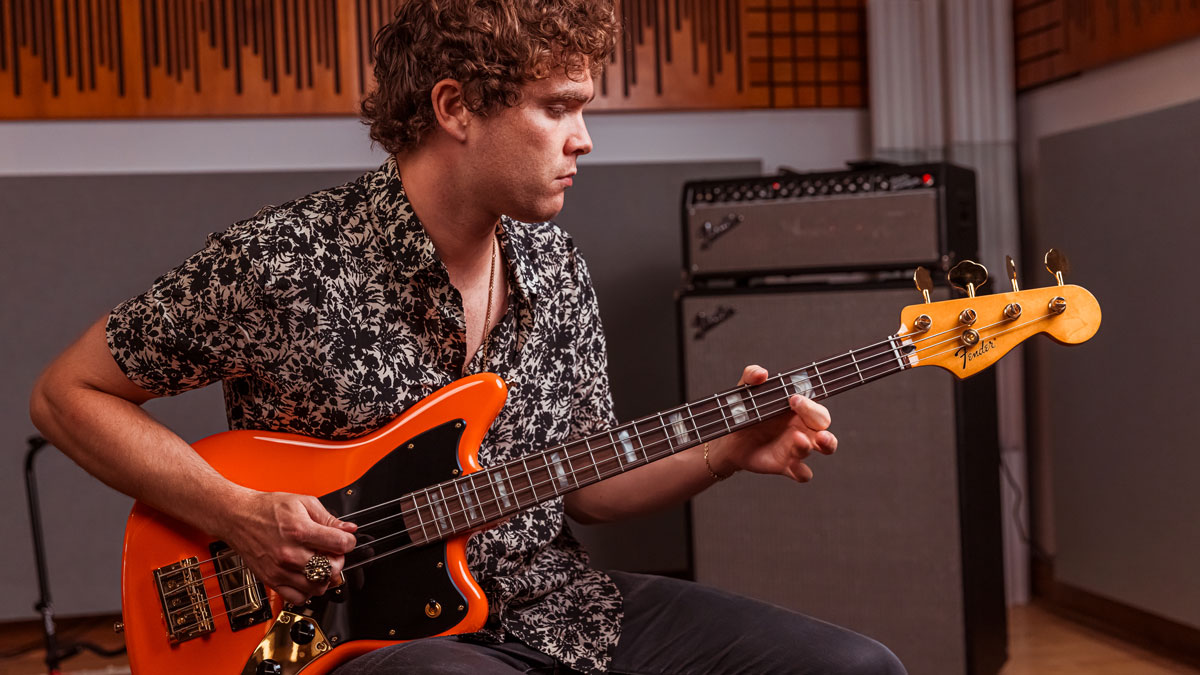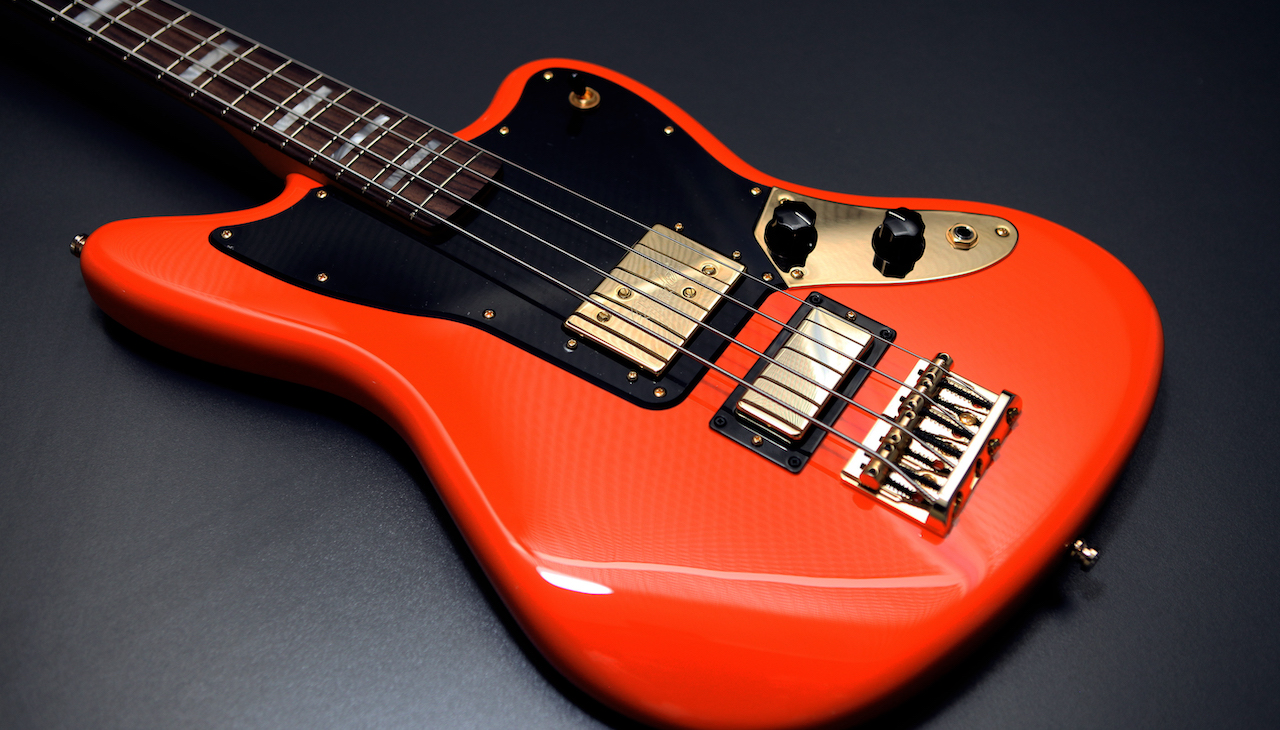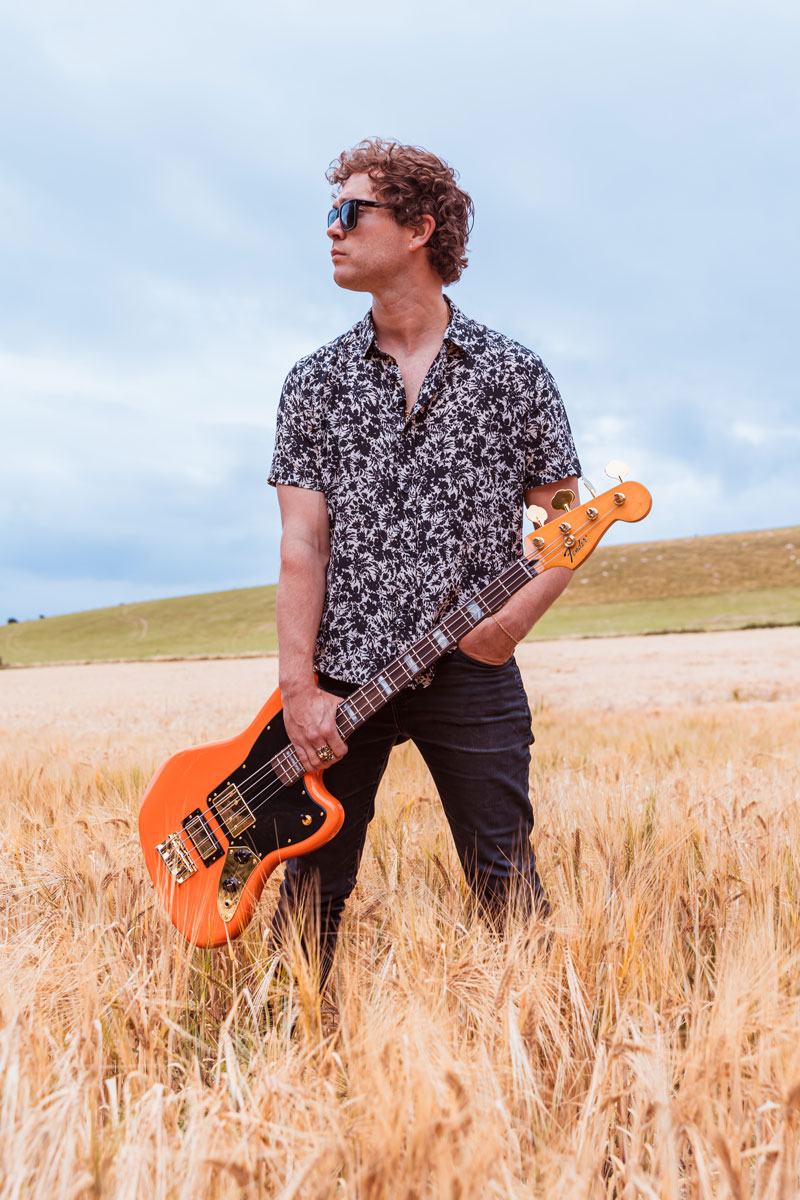“When I flick the pickup selector, it turns my bass into a Stratocaster!” Mike Kerr on how he broke all the bass rules for his signature Fender Jaguar – and why his “lack of ability” is key to Royal Blood’s astronomical success
His earthquaking live sound is bigger than most other bassists and guitarists combined, and now Kerr has a signature bass worthy of his epic tone. He reveals the secrets behind his rig, why shredding won’t conquer arenas, and what makes short-scale basses “feel like the 10-kilo vest has been taken off”

Royal Blood are known for many things: from being one of the most successful British rock acts to follow in the footsteps of Muse, Biffy Clyro and Arctic Monkeys – the latter of whom they share management with – to sounding impossibly gargantuan for a group with only two members.
No matter how many videos you watch on signal splitting and using different amps to fill up sonic space, seeing them live is always a mind-boggling experience, with singer/bassist Mike Kerr cleverly routing his Fender four-strings to effectively serve as a standalone bass, an Electro-Harmonix POG2-effected octave up ‘guitar’ or both combined.
Then, of course, there’s the smorgasbord of pedals he uses to help color in different lines, from the Boss PS-6 Harmonist and Boss GE-7 Graphic Equalizer to the Tech 21 Red Ripper Distortion and Z.Vex Mastotron Fuzz. This ingenuity when it comes to his rig, as well as his formidable talents as a songwriter, have led to the duo often sounding bigger and better than bands with twice as many members.
Next month, they will be unveiling their fourth full-length, Back to the Water Below, and building on the momentum that’s led them to topping the UK charts with every album thus far. But that’s not the only big release connected to the band right now, with the recent announcement of Fender honoring Kerr with his very own signature Jagua Bass.
Given he’s the living definition of a modern bass hero and a bona fide innovator when it comes to tone, it’s certainly well-deserved, and despite having tasted success so early on in his career, the Royal Blood frontman has still managed to keep both feet firmly on the ground.
“To be part of Fender’s legacy is insane,” he smiles, talking to GW from his home sofa in Brighton, England. “Playing bass is something I never set out to do – it’s just something I wound up doing. To go from finding myself playing bass to this point now, where I have a stamp on the bass world, is quite remarkable. It’s taken a little bit of time to process.
“The conversations around having a signature bass have been ongoing for a long time. It felt like it was one of those things we spent ages talking about doing, so now it’s a reality, it’s nice to finally be able to talk about it in depth!”
Get The Pick Newsletter
All the latest guitar news, interviews, lessons, reviews, deals and more, direct to your inbox!

As you’d expect from the person singlehandedly in charge of all things melodic in Royal Blood, this is no ordinary Fender bass. It features a Wide Range Humbucking Bass Pickup in the middle position and a high-output Custom Humbucking Pickup on the bridge on an alder body with a maple neck and slab rosewood fingerboard.
There’s a shorter 30” scale length as per the Gretsch Junior Jets and Fender Starcasters Kerr has used in the past, as well as gold hardware and a personalized graphic on the neck plate. Many might say the biggest talking point here, however, is the eye-catching Tiger’s Blood Orange finish...
“I’ve always loved that color,” continues Kerr. “It has this off-red and ’70s kinda look to it. And since I started playing the one I had custom-made, I noticed the finish got complimented a lot. So it felt obvious to do the signature in this color!”
Tell us more about the little humbucker in the bridge...
“The two pickups are so different to one another. To the point where when other people switch over to the bridge they might think ‘What the fuck is that, why does it sound like that?!’ It’s so outrageously different. There’s next to no bottom-end – it gets very throaty and twangy.
“Perhaps a traditional bass player might find it a bit bizarre. But for me, especially when I’m overdubbing and looking for interesting sounds to lay on top of what I’ve just done, it’s a really interesting tool to have because it sounds so different. There was always going to be a difference between the two pickups just because of their location, but I find hitting that switch and going through a fuzz pedal, it dramatically transforms the sound of the bass.”
And versatility is the name of the game, at least as far as your approach to gear is concerned, right?
“For sure. It’s an immediate way of getting different sounds. I guess it’s reminiscent of that tic-tac bass tone they’d use on Spaghetti Westerns where they’d have a sub sound and then overdub it with this twangier thing with all the spring reverb on it. I guess that’s a more traditional application for it and shows how versatile it could be. But for me I’m always shooting for more guitar sounds and using octave pedals, so when I flick over to that pickup it turns my bass into a Stratocaster, basically!”
Speaking of which, the power chords in the verse sections of new song Mountains At Midnight sound more like guitars than anything you’ve ever recorded!
“Exactly. Using that bridge pickup gets rid of some low-end and boosts the mids, so gives you a real headstart in nailing those kinds of [guitar] sounds.”
You’ve told us in the past how shorter-scale length instruments feel more natural to you, playing more like a guitar than a regular bass...
“Yeah! I mean I was playing the same way on larger basses, but when I started using short scales it was obvious that my playing style started making more sense. It can work the other way round, too – where your playing style is informed by the instrument.
“If you go to a guitar shop and try loads of instruments, you might come up with a new riff every time you pick a new one up and probably start pissing off the owner because you’re not buying anything – you’re just having your own little writing session [laughs]! Shorter scale basses do that for a lot of people, where suddenly it feels like the 10-kilo vest has been taken off and suddenly all these new ideas start coming out. It’s a great way of getting creative.”
And you’re still using Starcasters for some of the lower-tuned tracks...
“I use a Starcaster for Little Monster and How Did We Get So Dark. On the recording for Little Monster, I actually used a Junior Jet that was tuned down to C but it was pretty unplayable. That’s why the Starcaster came in, so I could play the lower songs live, but then I realized it had its own great tone, so it just stuck!”
The other new single, Pull Me Through, sounds simple but gets more complicated during the chorus sections, especially if you’re singing over the top...
“It’s funny – I reckon it takes me about 100 shows to feel like I can nail something. I’m only starting to feel like I can naturally play stuff from the last album right now. And yeah, like you say, Pull Me Through is definitely tricky in places. Though it’s not as challenging as Typhoons or Trouble’s Coming, which I still lose sleep over! But I guess I’m only playing my own songs, so it’s just a case of focusing on doing the same thing every night.”
What else can we expect from the new album? Both you and Ben [Thatcher, drums] have described it as a ‘back to basics’ affair that also treads new ground...
“What’s exciting about it is that it can’t be defined by one thing. Pull Me Through is somewhat of a blueprint for three other songs. So is Shiner in the Dark, but there are also tracks that go off into other places. It feels like a full spread.
“I think there’s something about things being in threes and that whole narrative we’re constantly hit in the head with about full circles and trilogies. I don’t know if that’s the story we keep telling ourselves or there’s something to it. It felt like Typhoons was the end of one cycle and now we’re onto another one.
If you’re absolutely shredding, nobody is going to sing along. I feel like my lack of ability is what has led me to that place
“We felt a lot less tied to what we’re known for and more open about where to go next. I also think we’re less afraid of what comes naturally. A lot of things were written and recorded simultaneously, not allowing space for thinking which can ruin everything. There was a real openness. We’d write something like Shiner in the Dark and think, ‘Okay, let’s write something completely different and see where we are led to next!’ That’s the theme of the record.”
There probably aren’t many connections between your band and Iron Maiden, but you both can write riffs that can get entire arenas singing along, in your case on tracks like Lights Out and Figure It Out. What’s the big secret?
“If I knew that, I’d be able to write one every 10 minutes! I guess it just started happening over time. Maybe we could sit here and try to work it out, but I really don’t know what the secret is. If I was to freestyle on it, I guess it comes down to things being melodic and not fast. If you’re absolutely shredding, nobody is going to sing along. I feel like my lack of ability is what has led me to that place. If I was able to play more notes faster, nobody would sing along… so my limitations have got me here!”
In our last interview you gave us a bit of an exclusive by revealing the Tech 21 Red Ripper was your ‘secret weapon’ distortion. Is that still on the ’board and is there any other new gear blowing your mind?
“Yeah, that one’s still on the board. In terms of new pedals, there isn’t much. On this record, I realized how time-consuming and distracting gear can become. I wanted to make it more about my playing and composition. Because in the past I’d find a whole day would go by and I hadn’t actually written anything – I’d just made a new sound that was different but nothing actually new. It was like a step sideways rather than forwards. But there must be something new I used… actually yes, I remember there was a Hagstrom [eight-string] bass!”
Do tell us more...
Stereo image is something I’ve been interested in since the very beginning of this band
“It was interesting because it already had that octave up sound naturally because it’s all doubled up. That was quite cool, but then I found I was using it differently, almost like a guitar, retuning it to major thirds instead of octaves. I ended up using that on two songs.”
How important is slightly delaying one of the signals when you’re splitting? There are pedals like the TC Electronic Mimiq Doubler that can help players sound wider...
“All I can say is that I’m doing it all the time [laughs]. Stereo image is something I’ve been interested in since the very beginning of this band. I like the idea of creating a bigger spread by using two different amps as a left and right, and then delaying one side from the other is how you’d make it sound wide and fun.
“In the studio, sometimes my engineer would struggle with that. It can make the mix feel really lop-sided because it’s this fixed thing. We found some clever tricks like making sure the left wasn’t always delayed to the right; instead we’d switch between the two. But yeah, I’m all about that kind of stuff. I love it and find it fun.”

You clearly have a very experimental attitude to the tools you use – even going as far as breaking convention by using guitar strings on bass...
“I think the thing about creativity is finding yourself a bit confused or doing something new. It’s a bit like what I was saying about picking up a new guitar to inspire new riffs. I get the same thing from confusing myself, whether it’s throwing on a guitar string somewhere random or using a different tuning.
“Whatever length I can get to where I find myself completely lost is a good thing. Because that’s when you start to use your ears again and you stop following patterns that you know work well for you. You start chasing the melody and it feels exciting again. That’s what I’m hoping for – feeling genuinely excited about sound or an idea.
It’s so easy to get caught in the motions of playing the same thing over and over again. It’s important to experiment
“It’s so easy to get caught in the motions of playing the same thing over and over again. It’s important to experiment. Sometimes once it’s written, I might even revert to playing it on a regular-tuned or strung bass, but it’s all about finding these ideas in the first place, you know?”
You’ve been known to use acoustic and electric six-strings for songwriting. So what kind of guitars would we find around your house and studio?
“The only guitar I have around me is my Gretsch acoustic. And there’s a limited-edition Strat I own, too. It has three humbuckers and is fun to experiment with. Apart from that, that’s kind of it, really.
“Ultimately, we’re trying to write songs. I’m always jumping from piano to acoustic when writing, particularly on this new album. I wanted to do the hard bits first, writing the lyrics and melodies – the actual song itself – and then plugging in the bass and asking myself, ‘Right, where do I fit into all of this now?’ That was way more fun. It felt like the riffs could support the songs in the most efficient way.”
Finally, what guitar bands have you been listening to recently and what does it take to impress you?
“I discovered this band called Bad Nerves recently. They were opening up for Black Honey in Brighton. Two songs in I was just like, ‘Yeah, this is it!’ They totally had me. It’s punk rock played super-fast but beneath it all, the songs and melodies are unbelievable. They have the same energy as The Hives. I texted Ben and said, ‘I’ve found our support band!’ He listened to them straight away and said ‘Yeah, great!’
“A couple of days later, we had them confirmed for our UK tour and now they’re coming to the US with us as well. It’s amazing to be able to find a band I love and then share the stage with them. I’m also aware there’s a gaping void between stuff I think that’s good and the stuff that blows me away. That’s why it’s important to act and respect those bands!”
- For more information on the Mike Kerr Jaguar Bass, head to Fender.com.
Amit has been writing for titles like Total Guitar, MusicRadar and Guitar World for over a decade and counts Richie Kotzen, Guthrie Govan and Jeff Beck among his primary influences as a guitar player. He's worked for magazines like Kerrang!, Metal Hammer, Classic Rock, Prog, Record Collector, Planet Rock, Rhythm and Bass Player, as well as newspapers like Metro and The Independent, interviewing everyone from Ozzy Osbourne and Lemmy to Slash and Jimmy Page, and once even traded solos with a member of Slayer on a track released internationally. As a session guitarist, he's played alongside members of Judas Priest and Uriah Heep in London ensemble Metalworks, as well as handled lead guitars for legends like Glen Matlock (Sex Pistols, The Faces) and Stu Hamm (Steve Vai, Joe Satriani, G3).
“I asked him to get me four bass strings because I only had a $29 guitar from Sears”: Bootsy Collins is one of the all-time bass greats, but he started out on guitar. Here’s the sole reason why he switched
“I got that bass for $50 off this coke dealer. I don’t know what Jaco did to it, but he totally messed up the insides!” How Cro-Mags’ Harley Flanagan went from buying a Jaco Pastorius bass on the street to fronting one of hardcore’s most influential bands




![A black-and-white action shot of Sergeant Thunderhoof perform live: [from left] Mark Sayer, Dan Flitcroft, Jim Camp and Josh Gallop](https://cdn.mos.cms.futurecdn.net/am3UhJbsxAE239XRRZ8zC8.jpg)









